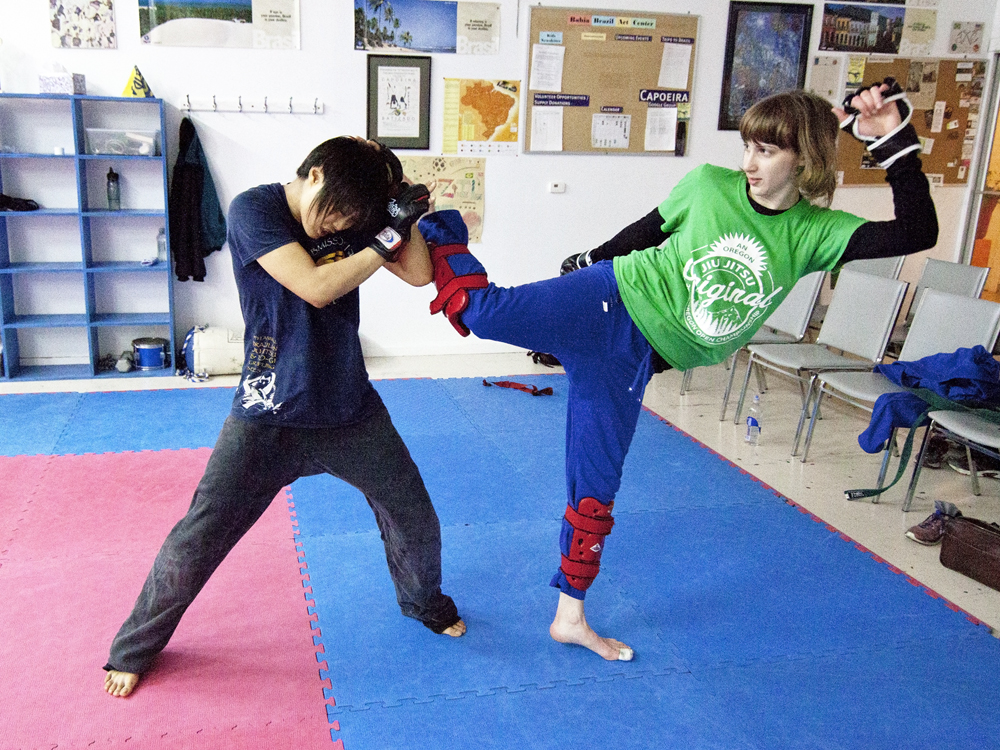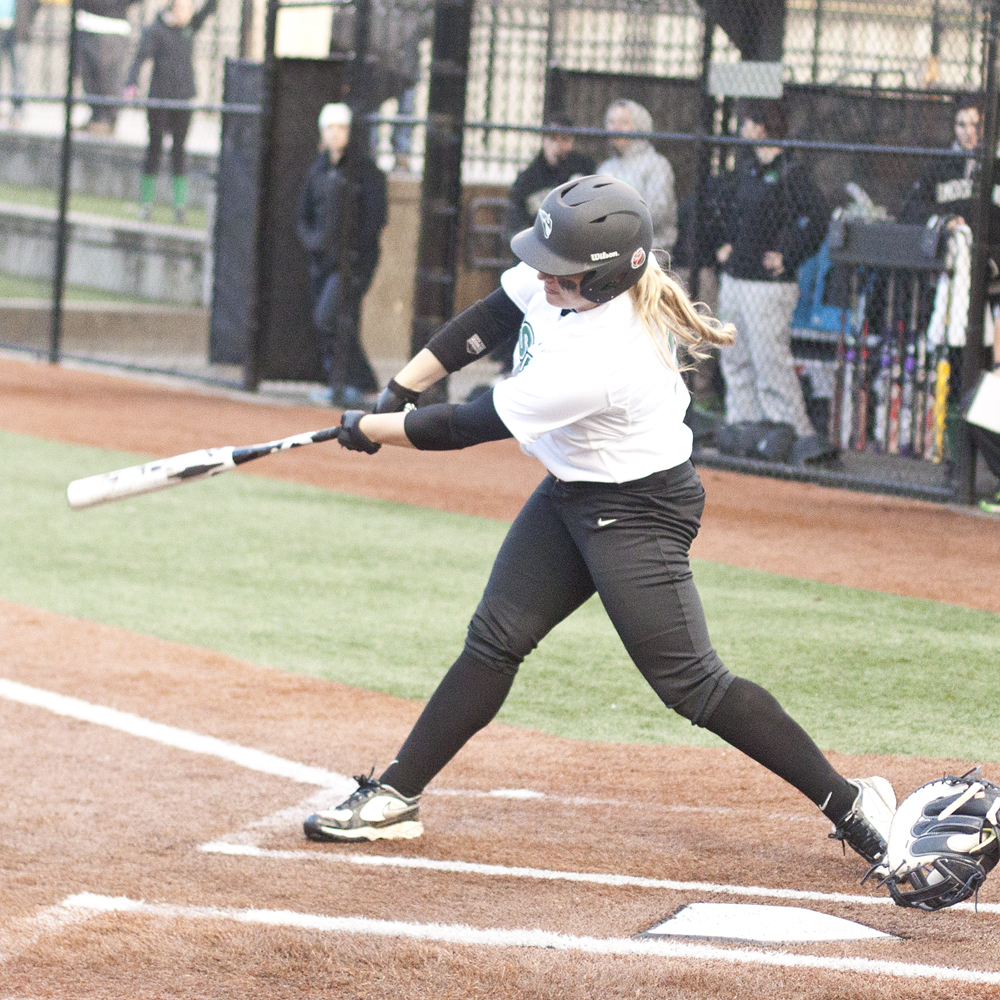Shoplifters beware: the next time you think about getting a five-finger discount at New Seasons you had better think again. Professional mixed martial artist Katie Howard might be lurking in the next aisle over.
On Saturday, G.I.R.L.S. Gym representative Howard (1–0 Pro) will be headlining the 77th edition of the Full Contact Fighting Federation’s Rumble at the Roseland. She will fight Glena Avila (2–2 Pro) in a 115-pound professional tilt.
The Rumble at the Roseland primarily features amateur contests. However, with the Ultimate Fighting Championship’s Ronda Rousey putting women’s MMA on the map again, as well as Howard’s recent upset victory at the preeminent regional event CageSport, this fight is a necessity.
For those reading who have never seen women fight in a skillful manner, this kind of thing might seem foreign or shocking to you. If you have been following the fight scene, the name Gina Carano might ring a bell. I alluded to Rousey putting women’s MMA back on the map. That is because Carano was the previous face of women’s mixed martial arts, until she was rubbed out by the one-woman wrecking crew that is Cristiane “Cyborg” Justino. Justino attempted to carry the banner for women. Unfortunately, she eventually failed a post-fight drug test for the steroid Stanozolol, calling into question the legitimacy of her previous victories.
Women’s mixed martial arts already had a cloud over it because of Justino’s manlike physique. The positive drug test was merely a confirmation of what everyone suspected all along. As a result, Justino was unceremoniously stripped of the Strikeforce 145-pound title she’d won by vanquishing Carano. Unfortunately, it was too late for women’s mixed martial arts; the damage had been done. As a result, Carano did what was best for her brain—as well as her bank account—and started acting. As for Justino? She has faded into relative obscurity.
After this fateful failed drug test in early 2011, I had written off women’s mixed martial. That was until I saw the FCFF poster featuring Howard, and assumed she must be pretty talented to be featured in a pro main event.
After watching what limited footage there was available on YouTube, I was thoroughly impressed with her ability to deliver crippling blows, as well as how effective she is in striking and hunting for submissions off her back. I was able to catch up with Howard and her coach Sarah Oriza, who were happy to answer random questions that came to my mind. Statements have been edited for clarity.
M.B.: Do you have a nickname?
K.H.: Not yet.
M.B.: Do you have a favorite food?
K.H.: Spaghetti and sushi, but I really love all kinds of food!
Oriza lets me know that while Howard is allowed to eat as much sushi as she wants, she has to maintain a fairly strict diet.
M.B.: How long did you train at G.I.R.L.S. Gym before you had your first fight?
K.H.: Two and a half years.
M.B.: Wow! So Sarah [Oriza] definitely made sure you were ready, and it looks like this has paid dividends in the way of wins. Is fighting your full-time job?
K.H.: Nope. I work at New Seasons.
M.B.: Do you have a favorite fighter?
K.H.: Nick Diaz is definitely one of my favorites.
As a personal aside, I too am a Nick Diaz fan. He dutifully plays the bad-guy role in the ring and gives almost lackadaisical interview responses when he is not in character.
M.B.: Is there a submission hold that you favor?
K.H.: Head and arm choke.
M.B.: Like an arm-triangle choke?
K.H.: Right!
M.B.: You were a huge underdog in your professional debut against world ranked Brazilian Jiu-Jitsu blackbelt Miriam Cardosa. What was it like to overcome those odds?
K.H.: I’m used to the pressure at this point. Plus, I’m usually the underdog anyway.
M.B.: Is it different for you now that you are fighting as a professional, rather than an amateur?
K.H.: Not really. I train the same. I train hard for every fight. Although the cage is bigger, and the rules are a little different.
Professional fights generally have five-minute rounds, whereas amateurs have three-minute rounds. Amateur does not allow elbows of any kind, or knees and kicks to the body of a downed opponent. Professional generally allows both of these things. Currently, only international MMA allows for kicks and knees to the head of a downed opponent.
We have a laugh as Oriza reminds Howard that she now gets a paycheck.
There has never been a better time to be fighting in the women’s 115-pound division. The Ultimate Fighting Championship is poised to crown a champion for their vacant 115-pound title, and straw-weights will be a commodity due to a current shortage of credible challengers. Accordingly, a few more wins in a row could see Howard getting a call with an invitation from UFC matchmaker Joe Silva.
As mentioned, the UFC is home to 135-pound women’s champion, Olympic bronze medalist and all around media darling Ronda Rousey. Rousey is able to regularly put butts in seats and create media buzz, a feat that would have proved impossible ten years ago. During the interview, Howard’s coach mentions that when she began fighting in 2006 there was virtually no money to be made for women. However, women’s MMA is back on the map, and with a high-level championship available. This will hopefully be the catalyst that entrenches women’s MMA in American popular culture.






